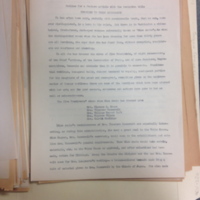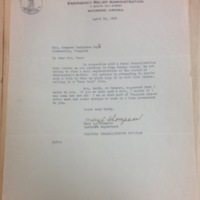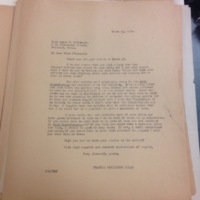Queen of Fiction : Preservation
Frances Parkinson Keyes was a collector of experiences, people, objects and houses. Experiences became stories. People provided her with facts about what she did not have at her fingertips. Material objects like dolls and fans and costumes were displayed in the houses that she painstakingly restored. Her passion for dolls stemmed from her childhood love of two dolls, Carol and Violet, and when she got older she acquired dolls during her foreign travels. According to one source, Keyes had over 200 dolls at the time of her death. She also had about fifty adult-sized foreign costumes, an impressive collection of veilleuses (small porcelain teapots), over eighty elaborate fans, and about 1,500 books. [1]
The material culture that Keyes surrounded herself with became part of her writing life. Keyes researched and analyzed the clothing on her dolls, corresponded with others who did the same, and then wrote up her findings. She studied how silver cutlery and metal fountains were made and used her knowledge not only in her novels but also in her presentation of gifts to and entertainments with friends and colleagues. At a housewarming party that Keyes threw when she moved into a new apartment in 1937, guests were served beer in “enormous glasses – much bigger than ordinary steins” that she had brought back from Europe. [2] In the center of the tea table was a silver duck that she received from a Chinese resident of Honolulu at a feast given in her honor and attended by the Governor of the Hawaiian Islands. Keyes’s “ability as a collector of rare object is well known, Christine Sadler wrote in the Washington Post,” and “it was from one of the historic maps hanging in her study that she took the title of Parts Unknown – which traces the life of a young American diplomatic couple in many different parts of the globe.” [3] Everything within her range of vision was useful to her as she wrote her books.
Keyes’s passion for houses stemmed from her pride in being born in the James Monroe House at the University of Virginia, the respect she had for the Johnson family homes in Newbury, Vermont, and her childhood visits to her paternal grandparents’ house, called the Count Rumford House or 1790 House, in North Woburn, Massachusetts. When she moved to Washington, D.C., Keyes initiated an effort to preserve the home of Robert E. Lee. When she settled into her new home in Alexandria, Virginia, she named it “Tradition” and began her first renovation project.
In the Old Gray Homestead, Keyes’s protagonist restores a dilapidated farmhouse where she is boarding and, in the process, restores the dignity and happiness of the family who live there. While working on Blue Camellia, Keyes bought, restored, lived in, and then sold a home in the Louisiana rice country. Her greatest success was the Beauregard House, which was threatened with demolition in 1925. To prevent the house’s destruction and the erection of a macaroni factory on its site, a group of women formed an association, raised funds, and were still in possession of it when Keyes moved into the house. She immediately began renovating both the house and the gardens. Among the changes she made was the installation of a garden fountain, which she had shipped from Wells River, Vermont. [4] In 1948, Keyes established the Keyes Foundation to ensure the house’s continued preservation. Today, the property is known as the Beauregard-Keyes House and is a house museum open to the public. Visitors can view her doll collection, a library of her novels, and other historic items.
Keyes continued to make her seasonal journeys between New Hampshire and New Orleans throughout the 1950s and 1960s. She also continued taking trips abroad, researching, writing, and collecting. She continued to collect honors, including honorary doctorates from Bates College and the University of New Hampshire, the Siena Medal as outstanding Catholic woman, and honors from the French and Spanish governments. As she aged, traveling became harder for her. In 1958, she began to use a wheelchair. Franklin Roosevelt, she said, was an “inspiration” to her. [5]
In June 1968, just a month before she turned eighty-three years old, a Boston Globe reporter interviewed Keyes, who was in Washington for a “lavish party” to celebrate the publication of her fiftieth book, The Heritage. [By our estimation, Keyes published a total of fifty-five books. This total includes her thirty novels and twenty-five non-fiction works but not reprints (sometimes under different titles), foreign editions, and translations of her works; her first book to be translated, in 1939, was Parts Unknown.] When one guest asked her how many books she had sold during her career, she replied, “I have heard the total put at 50,000,000 … but I don’t know.” [6]
Frances Parkinson Keyes died on July 3, 1970 in her beloved New Orleans home. She was buried in Newbury, Vermont at the Oxbow Cemetery alongside members of her family.
Notes:
1) This figures come from Laura McGill’s film, The Story of the Dixie Doll (United Federation of Doll Clubs, Inc., 2004. ↵
2) “Mrs. Keyes Is Hostess at an Unusual Affair,” Washington Post, November 8, 1937.) ↵
3) Christine Sandler, “Frances Parkinson Keyes Called One-Woman Corporation Who Can Crowd Week in a Day,” Washington Post, February 24, 1938. ↵
4) Samuel Wilson, Jr., The Beauregard-Keyes House (New Orleans: Keyes Foundation/Laborde Printing, 1993. ↵
5) Boston Globe, June 9, 1968. ↵
6) Boston Globe, June 9, 1968. ↵
Related Documents:




